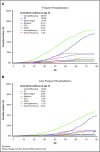Bleeding in patients with sickle cell disease: a population-based study
- PMID: 32108229
- PMCID: PMC7065478
- DOI: 10.1182/bloodadvances.2019000940
Bleeding in patients with sickle cell disease: a population-based study
Abstract
Bleeding is a known complication of sickle cell disease (SCD) and includes hemorrhagic stroke, hematuria, and vitreous hemorrhage. However, the incidence of bleeding events in patients with SCD has not been well described. We present a retrospective, population-based study examining the cumulative incidence of bleeding in 6423 patients with SCD from 1991 to 2014. We also studied risk factors associated with bleeding and the effects of bleeding on mortality, using Cox proportional hazards regression models. We used California emergency department and hospitalization databases to identify patients with SCD with intracranial hemorrhage, gastrointestinal (GI) bleeding, hemophthalmos, gross hematuria, epistaxis, menorrhagia, and other bleeding events. The cumulative incidence of any first bleeding event at age 40 years was 21% (95% confidence interval [CI], 19.8%-22.3%), increasing with age to 41% by age 60 years (95% CI, 38.8%-43.1%). The majority of bleeding events were GI (41.6%), particularly from the upper GI tract. A higher bleeding risk was associated with increased frequency of hospitalization (hazard ratio [HR], 2.16; 95% CI, 1.93-2.42), venous thromboembolism 180 days before bleeding event (HR, 4.24; 95% CI, 2.86-6.28), osteonecrosis of the femoral head (HR, 1.25; 95% CI, 1.08-1.46), and ischemic stroke (HR, 1.65; 95% CI, 1.20-2.26). Bleeding was also associated with a twofold increased risk for death (HR, 2.09; 95% CI, 1.82-2.41) adjusted for other SCD-related complications. Our novel finding of a high incidence of bleeding in patients with SCD, particularly from the upper GI tract, suggests that patients with SCD may be predisposed to bleeding, with possible etiologies including increased use of nonsteroidal anti-inflammatory drugs, mucosal infarction from vascular occlusion by sickled red blood cells, and increased stress ulceration from frequent hospitalization.
© 2020 by The American Society of Hematology.
Conflict of interest statement
Conflict-of-interest disclosure: The authors declare no competing financial interests.
Figures




Similar articles
-
High incidence of venous thromboembolism recurrence in patients with sickle cell disease.Am J Hematol. 2019 Aug;94(8):862-870. doi: 10.1002/ajh.25508. Epub 2019 Jun 12. Am J Hematol. 2019. PMID: 31074115 Free PMC article.
-
Increased incidence of VTE in sickle cell disease patients: risk factors, recurrence and impact on mortality.Br J Haematol. 2017 Jul;178(2):319-326. doi: 10.1111/bjh.14655. Epub 2017 Apr 3. Br J Haematol. 2017. PMID: 28369826
-
Time trends and impact of upper and lower gastrointestinal bleeding and perforation in clinical practice.Am J Gastroenterol. 2009 Jul;104(7):1633-41. doi: 10.1038/ajg.2009.164. Epub 2009 May 5. Am J Gastroenterol. 2009. PMID: 19574968
-
Lower gastrointestinal events in a double-blind trial of the cyclo-oxygenase-2 selective inhibitor etoricoxib and the traditional nonsteroidal anti-inflammatory drug diclofenac.Gastroenterology. 2008 Nov;135(5):1517-25. doi: 10.1053/j.gastro.2008.07.067. Epub 2008 Aug 3. Gastroenterology. 2008. PMID: 18823986 Clinical Trial.
-
Predictors and prognostic consequence of gastrointestinal bleeding in patients with ST-segment elevation myocardial infarction.Int J Cardiol. 2015 Apr 1;184:128-134. doi: 10.1016/j.ijcard.2015.01.041. Epub 2015 Jan 27. Int J Cardiol. 2015. PMID: 25703420
Cited by
-
Clinical Vignettes, Part II: Eyes, Teeth, and Bone.Hematol Oncol Clin North Am. 2022 Dec;36(6):1201-1215. doi: 10.1016/j.hoc.2022.08.010. Hematol Oncol Clin North Am. 2022. PMID: 36400539 Free PMC article. Review.
-
Musculoskeletal manifestations of sickle cell disease: an imaging perspective.Skeletal Radiol. 2025 Jun 21. doi: 10.1007/s00256-025-04975-6. Online ahead of print. Skeletal Radiol. 2025. PMID: 40542898 Review.
-
Neurovascular disorders in children: an updated practical guide.Transl Pediatr. 2021 Apr;10(4):1100-1116. doi: 10.21037/tp-20-205. Transl Pediatr. 2021. PMID: 34012858 Free PMC article. Review.
-
The Role of Antiplatelet in the Management of Sickle Cell Disease Patients.Cureus. 2023 Jul 18;15(7):e42058. doi: 10.7759/cureus.42058. eCollection 2023 Jul. Cureus. 2023. PMID: 37602132 Free PMC article. Review.
-
Venoarterial Extracorporeal Membrane Oxygenation Therapy in Patients with Sickle Cell Disease: Case Series and Review for Intensive Care Physicians.J Intensive Care Med. 2025 Sep;40(9):929-936. doi: 10.1177/08850666241260605. Epub 2024 Aug 14. J Intensive Care Med. 2025. PMID: 39140386 Free PMC article. Review.
References
-
- Ohene-Frempong K, Weiner SJ, Sleeper LA, et al. . Cerebrovascular accidents in sickle cell disease: rates and risk factors. Blood. 1998;91(1):288-294. - PubMed
-
- Ataga KI, Orringer EP. Hypercoagulability in sickle cell disease: a curious paradox. Am J Med. 2003;115(9):721-728. - PubMed
-
- Earley CJ, Kittner SJ, Feeser BR, et al. . Stroke in children and sickle-cell disease: Baltimore-Washington Cooperative Young Stroke Study. Neurology. 1998;51(1):169-176. - PubMed
Publication types
MeSH terms
LinkOut - more resources
Full Text Sources
Other Literature Sources
Medical

